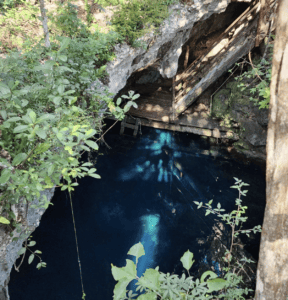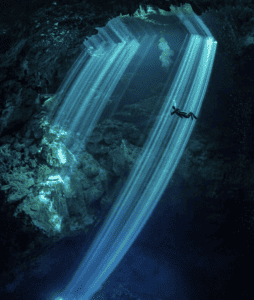Diving into Cenote El Pit is a bucket-list opportunity for many divers. This incredible DEEP adventure is well worth the trip to the Riviera Maya.
As an expert cenote guide and scuba instructor, who has dived in this incredible cenote too many times to count, let me take you on an in-depth journey of this mesmerizing dive site.
A Natural Wonder
Cenote El Pit is a geological gem situated in Mexico’s Riviera Maya, about a half-hour drive south of Playa del Carmen. It is situated in the Dos Ojos Cenote Park, which is home to many cenotes that make up the Sac Actun system, the longest underwater cave system in the world. It has over 364 km of explored tunnels.
El Pit, as it’s name suggests, is a large deep cenote, named as it it seemingly a bottomless pit! It is one of the deepest cenotes in the region, with a depth of around 40 – 45 meters. (Angelita and Maravilla are other deep favorites!)
This depth does mean that it is a cenote dive for divers who are experienced and have at least their Advanced Open Water Certification.
The water here remains a cool 26C year round, so a wetsuit is needed to not feel the chill of the water.

How Was Cenote El Pit Formed?
El Pit Cenote, like many cenotes found in the Yucatan Peninsula of Mexico, was formed through a natural geological process. The Yucatan Peninsula is made up of porous limestone, and cenotes are a result of the collapse of limestone bedrock, exposing groundwater underneath.
Over many thousands of years, the slightly acidic rainwater seeped through the porous limestone, creating underground rivers and caverns. The constant erosion of the limestone by water gradually weakens the rock structure. Eventually, the cavern ceilings weaken to the point where they collapse, forming sinkholes or cenotes.
In the case of El Pit Cenote, the collapse of the limestone bedrock created a deep circular sinkhole, exposing the groundwater beneath. This natural process created the breathtaking cenote that is known for its crystal-clear waters and impressive depth.
What Makes Cenote El Pit a Favorite Among Divers?
Cenote El Pit is loved by divers for several reasons:
Halocline Layers
One of the most visually special and exciting aspects of scuba diving at Cenote El Pit is the visual effect that happens when the saltwater and freshwater layers meet.
This phenomenon is known as a haloclinem and occurs when freshwater from rainwater or rivers, which is less dense, floats on top of denser saltwater.
When these two different densities of water meet, they create a visible boundary, or halocline, where the waters don’t mix immediately. This boundary can cause a distorted view underwater and create a cloudy or hazy appearance due to the differing refractive indexes of the two types of water.
This phenomenon can give the impression of a cloud-like layer or distortion in the water, and in the case of Cenote El Pit, you’ll experience it at around 12 meters deep.
Beyond that, at around 27 metres, Cenote El Pit, has a cloud-like layer of hydrogen sulfide.
This cloud or fog-like layer, is the result of hydrogen sulfide and other gases, which occur in some cenotes due to the decomposition of trees, leaves, and other organic matter that fall in from the jungle outside.
Bacteria breaking down the organic materials produce hydrogen sulfide gas, creating a cloudy appearance in the lower depths of the cenote. This cloud can give an otherworldly appearance and is often referred to as the Halocline Fog or Cloud.
This layer doesn’t pose a threat to divers or swimmers. Even though the cloud might resemble fog, it is harmless to humans. Divers who explore cenotes like Cenote El Pit or Cenote Angelita can pass through these layers without any risk.
In fact, the presence of the Halocline Layer in these cenotes adds to the allure and uniqueness of these incredible dive sites, offering a surreal experience for divers exploring these natural formations.

Laser Light Show
Descending into Cenote El Pit is like entering a different realm altogether. The initial plunge reveals the water’s stunning visibility, which is crystal clear.
Going on a sunny day is highly recommended, as the sunlight piercing the water’s narrow entrance creates huge laser beams of light that shine through the entire water column. It’s a visually ethereal experience.
Stunning Geological Formations
Diving at Cenote El Pit offers an extraordinary experience beyond the mesmerizing Halocline Layer. The incredibly clear waters of Cenote El Pit provide exceptional visibility, allowing divers to appreciate the beauty of the underwater environment and the various geological formations.
Around the cenote you’ll see impressive rock formations adorned with stalactites and stalagmites, creating an otherworldly underwater landscape.
Unique Ecosystem
Although not as diverse as open-water environments, cenotes still support unique ecosystems. While diving in a cenote, you might encounter small fish, freshwater crustaceans, and possibly some aquatic plants adapted to these unique conditions.
But don’t expect wildlife to be the star of the show here – cenotes are all about the marvel of the environment!

Photography at Cenote El Pit
Capturing the allure of Cenote El Pit requires underwater photography skills, but it’s worth it! The natural light that filters through the cenote offers a fantastic backdrop for stunning shots of divers floating in the abyss.
Remember to adjust your camera settings for the best results and, if possible, experiment with wide-angle lenses to capture the vastness of this underwater marvel.
Underwater cameras are allowed to be taken into Cenote El Pit. Small underwater cameras like GoPro are free of charge but use of professional ones have a charge of 300 pesos.
Be aware! Many a diver has been known to lose a Go Pro to the depths of the cenote (and if it falls beyond the cloud, you’re unlikely to recover it!) make sure you have it attached using a bungee cord, or strap!
Responsible Diving Practices at Cenote El Pit
To keep El Pit Cenote preserved and taken care of for future generations of divers to enjoy, responsible diving practices, such as proper buoyancy control and avoiding contact with delicate formations, are really important.
Frog-kicking is a good skill to master in order to become better at cenote diving and avoid kicking the delicate stalactites or flicking up sediment from the cenote floor.
Other Cenotes Nearby to El Pit
A diving day at Cenote El Pit can be combined with other cenotes within the Dos Ojos Park. As El Pit is usually the deepest cenote, you usually dive here first. (Plus the early morning gives the best light conditions – so it’s a win-win!)
Following your dive at El Pit, divers can head to Dos Ojos Cenote to experience the more shallow and different types of formations there, following the Barbie, or Bat Cave lines. The more advanced Taak Bi Ha, and Taak Bi Luum are also close by.
Dos Ojos Park also has a small restaurant on site, along with small shops to pick up souvenirs to buy as a lasting memento of your dive.
Experience El Pit Cenote with DivePoint
At DivePoint, we offer specialized tours designed to immerse you in the mesmerizing world of Cenote El Pit. Dive into the crystal-clear waters and witness the awe-inspiring Halocline Layer, a natural phenomenon that adds an otherworldly dimension to your diving experience.
Enhance your adventure by customizing your visit to the Riviera Maya with our dive packages, which combine the exploration of the cenotes with ocean dives, providing an unforgettable combo of the Riviera Maya’s finest dive sites.
Contact us today to book your adventure! Happy Diving!


